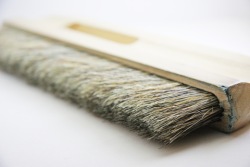Strie faux painting will transform a boring room into a fresh, chic room in just hours. Much easier to apply than wallpaper, strie painting offers the look of a rich fabric without the expense or hassle. And rather than flipping through a book of wallpaper samples searching for just the right color, strie faux painting allows you to create a room in any color you please.
Simply put: Strie faux painting is adaptable, easy, and inexpensive, with loads of reward.
So what is this great faux painting technique?
Strie faux painting is a decorative painting technique that creates the look of crisp linen or fabric by dry brushing through wet glaze vertically and horizontally. The resulting pattern mimics the criss-crossing threads of fine linen. You can strie paint just one accent wall, or envelop an entire room.
Important note: Due to the nature of the strie painting technique, it can only be used on walls that have a smooth surface.
Choosing the right color for your strie painting project.
Choosing the right color to strie paint your room is essential to achieving the look and feel you’re striving for. So spend some time in the room you plan to strie paint to get a sense of the mood you want the room to evoke. Chose pastels for a sunroom, kitchen, or nursery; bold primary colors for a play room; or earth tones for a home office, dining room or elegant powder room.
The latex paint you select for the top coat will be the prominent wall color. The latex paint you chose for the basecoat will offer a nice background contrast to the topcoat and show through just slightly.
Think carefully about how the colors will work together. Usually, a white or off-white basecoat offers the best strie painting results.
Tools and materials for strie faux painting.
- Drop cloth or other protective material for your work space
- Ladder (if necessary)
- Tools to remove switch plates, etc. from wall
- Clean, lint free rags

- Latex paint for basecoat (eggshell sheen)
- Latex paint for topcoat
- Latex glaze
- Paint roller
- Two paint trays
- Painter’s bucket
- Paint pad
- Stiff 2″ bristle brush
- Stiff 4″ bristle brush or faux dragging brush
- Spray bottle filled with water
How to strie faux paint.
- Prepare the wall. Remove pictures and switch plates, and be sure wall is free of dust. For the best strie faux painting results, repair any cracks or holes with spackling paste prior to painting. Prime the wall if necessary, and then use a paint roller to apply a basecoat of latex paint in an eggshell finish. Let dry.Tip: Choosing a light color for your base, such as off-white, will make for a lovely contrast against a darker topcoat.
- Prepare the glaze. In a plastic painter’s bucket, combine one part glaze with one part of the topcoat latex paint and two parts water. Once mixed well, pour into the paint tray.Tip: Be careful not to thin the mixture too much, or it will become runny and then drip when applied to the wall.
- Apply the paint/glaze mixture to wall. Dampen the paint pad by spraying it with water. Dab the paint pad into the paint/glaze mixture. Avoid soaking the paint pad with the paint/glaze mixture. Start at the top left corner of the wall, and apply the paint/glaze mixture to the wall using the paint pad. Long strokes from ceiling to floor bring out the best strie painting effect.Tip: Work in small sections, so that the paint/glaze mixture does not dry on the wall before you can dry brush through it.
- Dry brush the wall vertically. Using the 4″ bristle or dragging brush, drag the brush through the wet paint/glaze (again, start at the ceiling and work toward the floor, creating vertical lines.) Push brush against the wall with a good amount of pressure. Remember, your goal is for the brush bristles to remove some of the paint/glaze mixture, leaving thin lines.For an unbroken look, overlap each stroke slightly. As the brush becomes heavy with paint, wipe it off on a lint free rag. The bristles must be relatively dry for the technique to work. Repeat steps 3 and 4 until you’ve entirely strie painted the wall vertically. Let dry completely.
- Dry brush the wall horizontally. Repeat step 3, except now you will apply the glaze horizontally and dry brush the wall horizontally.Tip: Use a smaller, 2″ bristle brush for tight areas.
Practice the strie technique on a large piece of foam board before you undertake an entire wall. The most difficult aspect of strie painting is working quickly with the dry brush before the paint/glaze mixture dries on the wall. Practicing will help you become fast and efficient, producing the most professional strie painting effect.
Related Articles
How to use a guide to make even paint combing lines.
Combing Paint Effects – Have Fun Choosing Your Paint Combing Tools


